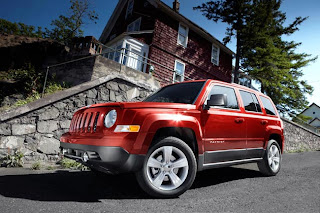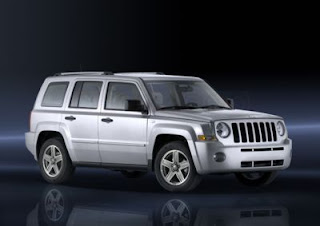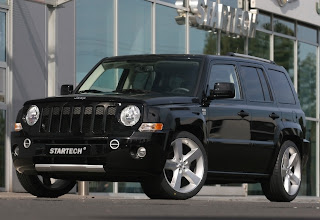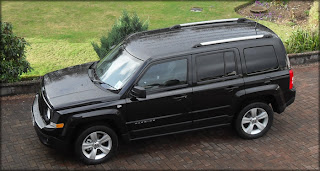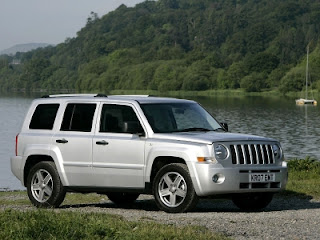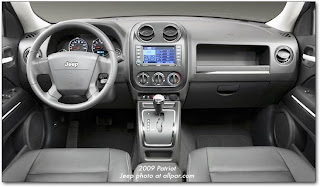The Jeep Patriot: 2006-2014
Like the Compass, the Jeep Patriot shared the Caliber platform, but it also had “real Jeep” capabilities. With styling similar to the 2008 Liberty, the Jeep Patriot was close in specs (save for the approach angle) but had far better gas mileage and a lower price. Testers were surprised by its rock-climbing, trail-traversing, and stream-crossing abilities. The body was similar in size to the old Jeep Cherokee. For model-year 2014, which will arrive around February 2013, reliable source oh2o said that there will be a new six-speed conventional-automatic transmission on Compass and Patriot; according to discussions at the Allpar forums, it will likely be the same one used on the Kia Sportage and Hyundai ix35, hooked up to a Magna Dynamax all wheel drive system.
Jeep Patriot is to end production a few months before Compass but still ending up in the 2014 model year (plans are likely to change depending on sales).I went to Chrysler’s off-road course in Chelsea, Michigan (within the famed Proving Grounds) to see if the Compass and Patriot were really Jeeps, or just mis-badged weenies. I asked Dave Vrabel, Wrangler Program Manager and a much more experienced off-road driver, to pilot a Trail-Rated Compass for me — because I figured the Compass would be handled more roughly and fully by Vrabel than by journalists who did not want to break it. It turned out to be a good decision, because Mr. Vrabel took the course at higher speed than I did, and gave the Compass a tougher workout. Afterwards, I took the Patriot around the course, over the same obstacles. As a disclaimer, I am not an experienced off-roader or Jeeper; just a journalist.
Knowing that the Proving Grounds’ roads were carefully engineered, with exact replicas of real-world challenges, we can assume that the off-road course was created, and is maintained, deliberately to seek out and expose weak areas. This was not a special course for journalists; it is used for testing vehicles that need off-road capability.
Unfortunately, the course doesn’t show up well in my photography, taken from within a vehicle as it was bouncing around the trail. The ideal for us would have been to get out and photograph the Jeep, but that was not in the cards, mainly because the Jeep people wanted everyone alive and well at the end of the day, despite the 104°F heat.
The Jeep bounced along the dirt road without problems, but I can do that in a minivan, too. It went up the railroad-tie steps in the photo above, but again, that really just requires ground clearance, which most AWD crossovers have, and either skid plates or the willingness to tear off a few bits from underneath. What the photos don’t show well is how the Compass climbed up out of pits, ran through the water without hesitation or excess “pulling,” and how many times the Compass slammed down onto rock or ground or logs without any damage. It had been doing so for around six hours, nearly continuously, as a steady stream of writers had gone out...and I have no doubt that many of them were as inexpert as I was, but less cautious.
The first drop set the tone — and even if I had tried to provide a photograph, you wouldn’t see much in it. The trail started with a moderately steep hill, and then a sudden drop into a pit; the vehicle slammed down, hitting something hard, and Dave Vrabel turned to me and grinned, saying, “That’s why we have skid plates.” He’d hit the pit harder than he intended to, (or at least I think he did), but that was nothing... in the Patriot, I slammed into it, quite accidentally, with a jar that knocked my hands off the steering wheel.
One place where the camera was definitely insufficient was with the shot above. It looks like a gentle slope; it isn’t. This little “bridge” was quite steep, ascending like the railroad-tie steps; unfortunately, getting out and shooting it from the side was “not on.” While Dave Vrabel was able to easily traverse it in the Compass, with no more than a gentle scrape, I was more ham-footed on the gas and slammed the bottom of the Patriot down hard on the top log, with no visible effect on the car.
Compass’ plates are not all-encompassing, but they worked for the situations we ran into, (or Chrysler would have modified either the course or the Jeep). Wrangler and the Grand Cherokee Trailhawk are more seriously outfitted, but the Compass did things I did not think it could — including surviving the slams, bounces, and rough treatment with no visible changes, no rattles, no shakes, and no difference in how it felt when we got back.
Ideally, the suspension would have more articulation, so we’d always have all four wheels on the ground, but as it was, we did not get stuck, even on the “wave course” — a set of rocks that test cross articulation, lifting up two tires on opposite sides at once. That part of the course, which had a dirt road around it in case one wanted to bypass it, causes the body to flex and tests the strength of the welds and joints, as well as making sure that the weaknesses of independent suspensions are addressed. It was one of the few places where left and right wheels were clearly and deliberately treated in opposite ways (one raised, the other dropped), though there were also trenches or mounds on one side only.
Overall, I gained a much higher respect for the Trail-Rated version of the Jeep Compass. Driving through, the Compass and Patriot felt confident and stable throughout the time, and though I personally hit a couple of deceptive places too quickly, resulting in plunge-then-slam!, neither car showed any signs of damage or any problems when we were done.
In the end, I got the idea that the Compass was in its element driving off-road, whether simply taking a badly maintained dirt road at a reasonable speed (rather than crunching along at 5 mph) and being tossed around inside the cabin, or going through a somewhat tougher course such as the one at the Proving Grounds, or, for that matter, simply eschewing roads entirely. It isn’t a rock-crawling demon like a customized Wrangler, and suspension articulation and ground clearance and skid plate coverage are all still issues on tougher routes; but there are, nonetheless, few if any competitors in the Trail-Rated Jeep Compass’ particular segment, and it still has what it takes.
Does this mean I approve of the “flexible” Trail Rated system, or have no concerns about Jeep “dumbing down”? No, but I’m a lot more confident than I was. Experiencing the reality of the Jeep Compass inspires confidence in the next generation. I personally believe, after speaking with Mike Manley and other Jeep and Mopar people, that Jeep is planning a U-turn. Its Trail Rated vehicles will, I think, be more impressive in their next generations — and in their current generations, they are, as modified under Sergio’s leadership, an evolution of Jeep rather than treason against the brand. For 2011, the body was “cleaned up,” with corners rounded off, and the back muffler mostly covered or blacked out. Real-world gas mileage should be better and the 2.4 is a little quieter; steering and handling are tighter as well. Jeep reps noted that the 2011 Patriot has revised front and rear fascias, a body-color grille, and an increased (by 1 inch) 4x4 ride height. Ride-and-handling was refined through retuned steering and suspension systems. Other changes include standard fog lamps within the headlights, four new colors, and optional 17 inch wheels. Highway mileage jumped by 2 mpg with the 2.4 liter engine and CVT for both FWD and 4x4 (except with Freedom Drive II).Interior enhancements include new soft touch front-door trim panels with a padded upper surface; new center armrest; a new steering wheel with integrated controls that allow the driver to operate the radio, cruise control, phone, and other functions while keeping their hands on the wheel; new cloth interior, with premium cloth bucket seats in the front; standard speed control on all models; new backlighting of door switches, door locks, windows and power mirror controls and standard automatic temperature control on the Latitude X model
Jeep Patriot vs Evoque (by Bob Sheaves, suspension engineer)
In concept of powertrain layout and function, there are no major differences between Land Rover Evoque and Jeep Compass/Patriot. They are all wheel drive capable, but the Jeep Patriot (and now Compass) has a low range option that is included in the Trail Rated offroad equipment package.
Suspension tuning and geometry is superior in the Evoque, but not due to more travel. The D-cars all have within one inch or so travel of each other, from jounce to rebound. The Evoque is “better” because the suspension controls the ground contact patch more accurately, without excessive toe change, caster change, or camber change, at the limits of travel. The Evoque not only keeps the tires perpendicular to the traction surface, more importantly, it keeps the tires pointed in the proper direction, relative to the direction of travel, although not always where the driver intends.
The spring rate on the Evoque is a little soft for my tastes- I would have used a slightly stiffer spring to lessen the jounce issues of the existing Land Rover design, but this would be a noticeable increase in onroad ride harshness. Also, the shock stiction is a bit high on the existing shocks, versus the Dodge and Jeep triplets. A minor point overall.
Overall, the existing Land Rover Evoque and Jeep Patriot are so close, they can be considered equal on or off road.
Optional on all models for 2011 is the Uconnect® Voice Command with Bluetooth for hands-free calling and music/radio/SIRIUS satellite radio control.
The 2011 Jeep Patriot 4x4 includes a low-range mode which generates a best-in-class 19:1 crawl ratio, brake traction control, 19-inch water fording capability, Hill Descent Control, 4x4 Lock shift-on-the-fly which sends 50 percent of torque to front and rear wheels, and a maximum tow rating of 2,000 lbs. The 2011 Jeep Patriot has higher spring and damping rates, added rebound springs, and an increased diameter of the rear sway bar; but has the best 4x4 fuel economy in its segment. The engine continues to produce 172 hp and 165 lb-ft of torque, and gas mileage is 22 city, 28 highway (the FWD Sport model has an available 158 hp 2-liter that has 1 mpg better mileage.)
A 2010 Insurance Institute for Highway Safety (IIHS) Top Safety Pick, the Jeep Patriot for 2011 is loaded with more than 30 standard safety and security features, thoughtful functionality and best-in-class off-road capability with Freedom Drive II, offering tremendous value for consumers that desire an SUV to accommodate their active lifestyle at an affordable price.
Jeep Patriot is available in three configurations – Sport, Latitude and Latitude X — all in front or four wheel drive. It was due by the end of 2010.
2009 and 2010 Jeep Patriot changes
Compass and Patriot shared an interior; for 2009, it was improved with more padding, better materials, and more graceful lines and curves. A partial-zero-emission-vehicle version of the 2.4 liter engine became available with front wheel drive. The suspensions were also retuned for a better on-road feel.A new instrument panel, door trim panel, and center console were accompanied by a soft-touch door armrest and center console with split lid for more storage. Chrome accents were added to the vents and shift bezel on Sport, and to those areas as well as the door and cluster rings on Limited. Floor mats replaced the vinyl load floor, and LED-illuminated cupholders were added.
An optional 30-gigabyte-hard-drive music system with the ability to show custom images (and to play movies on the screen while in Park) was added, along with a nav/traffic system, the latter standard on the Limited. Numerous changes were made to options packages, including a rather comprehensive and credible Freedom Drive II group. The liftgate appliqué was switched to mold-in-color (all Patriot, and Compass Sport; Compass Limited got a body-color appliqué).
Engine compartment and floor sound insulation and a larger resonator on front drive vehicles (and the addition of a resonator on 4WD models) slashed unwanted noise. Other changes included making a PZEV option on FWD CVT models, and making the Sport's suspension more comfortable and smooth. For 2010, a 2.0 engine option with the five-speed stick-shift raises gas mileage slightly (by 1 mpg highway vs the 2.4 engine). Active head restraints were standard for drier and passenger. Automatic climate control was optional on Limited, and remote start was optional with the Security Group
The vehicle: Jeep Patriot
Based on the Jeep Patriot concept (see below), the 2007 Jeep Patriot combined the packaging of an SUV with the performance, handling, fuel economy, and price of a compact car or small pickup. New Jeep technology gave Patriot more capability than any other vehicle in its class when fitted appropriately.Most Capable Off-Road Vehicle in its Class
While the Patriot was available with front wheel drive, two optional four wheel drive packages were available: Freedom Drive I and the Freedom Drive II with an Off-Road Package.
(All but RAV4,
Patriot are 2006 models)2006
Toyota
4Runner2007
Toyota
RAV42006
Honda
Pilot
2006
Wrangler
Rubicon2006
Liberty
Limited2006-11
Jeep
Patriot2006-2010
Patriot
FD II2011-12 Patriot Running ground clearance 9 7.5” 8” 10” 9.4” 8.0”* 9.0” 8.2” Approach angle (degrees) 31 29 28” 44 37 27.4 29 26.4 Departure angle (degrees) 24 25.4 21” 40.4 31.5 31.4 33 31.2 Breakover angle (degrees) 28 25 21” 25.4 22 20.6 23 18.4 Water fjording (inches) 19 * 2011 Patriot should be one inch more, in 4x4 mode, even without Freedom Drive II.
Freedom Drive I was a full-time, active four-wheel-drive system for rough weather and low-traction conditions that was designed for daily use. Freedom Drive I featured a lockable center coupling, giving the ability to put the Jeep Patriot in four-wheel-drive Lock mode to handle deeper snow, sand, and other low-traction surfaces.
The Freedom Drive II Off-Road Package was needed to add the Trail Rated certification. The Freedom Drive II Off-Road Package included a second-generation continuously variable transaxle with a low range (CVT2L) that engaged when the off-road mode was activated, 17-inch all-terrain tires and aluminum wheels, a full-size spare tire, air-filtration system, skid plates, tow hooks, fog lamps and seat height adjuster. The Freedom Drive II Off-Road Package was for true off-road situations that included steep grades, wheel lift and rock or log climbing.
This new Jeep technology included the CVT2L’s best-in-class 19:1 low ratio, which was ideal for crawling over obstacles. Off-road Brake Traction Control maintained forward mobility during heavy articulation or on split-friction surfaces where one wheel loses traction. Hill-Descent Control modulated brake hydraulic pressure without driver intervention for downhill assistance at a safe and controlled rate of speed. Three-mode ESP and off-road anti-lock brakes (ABS) also added to the Patriot’s off-road capability.
The Trail Rated Jeep Patriot sat 1 inch higher than non-Trail Rated versions and met Jeep off-road capability requirements for traction, water fording, articulation, maneuverability and ground clearance, including 9 inches of ground clearance, a 29-degree approach angle, a 33-degree departure angle and a 23-degree breakover angle. This version of the Patriot also had additional body sealing and high-mounted drivetrain vents to support 19-inch water fording capability. In fact, the Jeep Patriot’s body and chassis were developed and tested over numerous rugged off-road terrains to meet the requirements of the enthusiast Jeep customer.
U.S. Sales Dodge Caliber Jeep Compass Jeep Patriot Total 2006 92,224 18579 0 110,803 2007 101,079 39491 40434 181,004 2008 84,158 25,349 55,654 165,161 2009 36,098 11,739 31,432 79,269 2010 45,082 15,894 38,620 99,596 Jan-Aug 2011 28,038 29,591 38,841 96,470
“From its approach and departure angles to every sealant and chassis component in between, Jeep Patriot is engineered to be the most capable vehicle in its class,” said Matt Liddane, Chief Engineer – Jeep Patriot. “Whether climbing rocks, stair steps, logs or steep grades, Jeep Patriot drivers will have the confidence of knowing they’re in a Jeep 4x4.”
All Jeep Patriot models available in the United States and Canada included standard Brake Traction Control, driver-controlled three-mode ESP, Brake Assist, Electronic Roll Mitigation and anti-lock brakes with rough-road detection. Patriot’s standard four-wheel anti-lock brakes provided a competitive 60–0 mph stopping distance of 134 feet on dry pavement.
Patriot produced
The first 2007 Jeep Patriot came off the assembly line of the Belvidere plant on December 20, 2006, nearly one full year after the Caliber started up and about six months after the Compass. "We are now seeing the results of our flexible manufacturing strategy that leads to a competitive advantage for the Chrysler Group," said Frank Ewasyshyn, Executive Vice President - Manufacturing. "Thanks to Belvidere's ability to build multiple models off one assembly line, we expect the production of three all-new models to cost significantly less than the initial investment we made in the plant to build one product."
Many changes were taking place within the Chrysler Group manufacturing process to accommodate the multiple models. For example, new ways to make the required amount of stamping dies were saving the company up to 60 percent on the cost of dies.
New methods of material flow were being implemented to manage the complexity of three models being built on one assembly line. The inbound parts sequencing center (operated by minority-supplier TDS/US) managed more than 1,799 different parts that were used in the Jeep Compass, Dodge Caliber and Jeep Patriot build process. This center provided parts metering, kitting and container management to the Belvidere Assembly Plant and delivered complete subassemblies to the manufacturing floor as they were needed.
A tunnel connected the 500,000 square-foot sequencing center to the assembly plant. TDS/US organized parts, put them in kits, and delivered them to the end of a connecting tunnel for Belvidere employees to transport. This process maintained in-plant stocks at optimal levels, minimized delivery time and reduced costs an estimated 12 percent a year compared with the previous process. By carefully managing the material flow at the plant, the sequencing center helped workers focus on manufacturing quality (delivery of the parts this way also provided a poka-yoke system).
A new workplace organizational model, coined Smart manufacturing, was increasing the flexibility of the Belvidere workforce, while fostering greater creativity and innovation from plant employees. In addition to extensive training, the new workplace model let employees design their own work stations. These changes provided a better work environment for employees and gave increased support to assembly line team members.
Jeep Patriot Styling
Patriot was designed to appeal to compact SUV buyers who wanted traditional Jeep styling with best-in-class off-road capability. “Simple yet distinctive geometric forms and planar surfaces define Jeep Patriot’s timeless proportions” said Trevor Creed, Senior Vice President – Design. “Combined, these features give Jeep Patriot its robust, strong, capable off-road image.”
Jeep Patriot was built for maximum cargo volume, rugged driving conditions and excellent utility. Patriot’s face was classic Jeep, featuring the brand’s signature seven-slot grille, a robust bumper and round headlamps. A stiffer windshield and upright backlight combined to create Patriot’s easily identifiable side view. Classic Jeep design cues included available 17-inch aluminum wheels and all-terrain tires housed inside signature Jeep trapezoidal wheel openings. Jeep Patriot’s high beltline completed the vehicle’s protective side profile.
The rear of the vehicle featured an upright backlight and a bold bumper that further illustrated the Jeep Patriot’s interior spaciousness and added to its rugged appearance and capability. Four doors and a rear liftgate provided easy access to Jeep Patriot’s spacious and functional interior.
Jeep Patriot utility and features
Jeep Patriot’s flexible interior gave buyers the capability to do more in terms of seating friends and storing gear. A command-of-the-road seating position gave drivers an added feeling of control. Jeep Patriot had 39.6 inches of rear seat leg room, 54.2 cubic feet of cargo space with the rear seats folded flat and 62.7 cubic feet of cargo space with the front passenger seat back and rear seats folded flat, giving plenty of room for an 8-foot ladder, skis or two-by-fours from the lumber yard.
In addition to interior spaciousness and flexibility, Jeep Patriot had many clever and unique available interior features that added functionality not typically found in a compact SUV, including:
- Standard side-curtain air bags
- Available nine-speaker Boston Acoustics Premium Sound Group that included two articulating speakers packaged in the liftgate; when the liftgate was open, the speakers swung down to face rearward for tailgating and other activities
- Auxiliary audio input jack for MP3 connectivity on standard radio
- Available dual purpose, self-recharging removable cargo lamp, which was mounted in the headliner above the cargo area and can snap out of the bezel to serve as a flashlight
- A sliding center armrest that moved forward 3 inches to accommodate shorter drivers. The armrest lid included a unique flip pocket for storing a cell phone or an MP3 player
- Available 115-volt outlet in the center console that powers small electronics
- Available fold-flat front passenger seat that creates a table-like surface for versatility
- Standard 60/40 rear seats that fold flat and have an available recline feature
- Ultra Floor™—a washable and removable vinyl load floor in the rear cargo area with a 250-lb. load capacity
- YES Essentials™ Fabric—an easy-care, soil-repellant and anti-microbial textile that protects seats from stains, odors and discoloration
- Available Navigation System
Powertrain - Jeep Patriot
The 2007 Jeep Patriot’s powertrain was designed to deliver world-class performance, fuel economy and refinement, all at an affordable, entry-level price.
Patriot featured a standard 2.4-liter World Engine that produced 172-horsepower and 165 lb.-ft. of torque. This 2.4-liter World Engine had dual Variable Valve Timing (VVT) on both intake and exhaust camshafts, which helped optimize the torque curve at all speeds and produced more power, better fuel economy and smoother, quieter operation than engines without dual VVT. Dual VVT was a technology typically not available on vehicles sold in the United States in the Jeep Patriot’s price class.
Jeep Patriot had a standard Chrysler-engineered T355 five-speed manual transaxle and an available CVT (continuously variable automatic transmission).
A 2.0-liter turbo diesel engine, paired with a six-speed manual transaxle, was available for Jeep Patriot in key diesel markets outside North America.
Jeep Patriot Line-up
The newest Jeep was available in both Patriot and Patriot Limited models. Both were available in the United States and Canada with front-wheel drive, the Freedom Drive I full-time, active 4x4 system and the Freedom Drive II Off-Road Package full-time, active 4x4 system with low-range capability.
The Jeep Patriot included a standard 172-horsepower 2.4-liter World Engine coupled with a five-speed manual transaxle. Other standard equipment included standard side-curtain air bags, ESP, Brake Traction Control, electronic roll mitigation, anti-lock four-wheel disc brakes, Sentry Key theft-deterrent system, Vinyl Tech seats, rear 60/40 fold-flat seats, an Ultra Floor vinyl load floor, AM/FM single-disc CD radio with an auxiliary audio input jack, outdoor temperature display, 12-volt power outlet, manual windows, locks and foldaway mirrors, tilt steering wheel, dome and cargo lights, rear window defroster and a center console sliding armrest that moves forward 3 inches to accommodate shorter drivers. The armrest lid featured a unique flip pocket for storing a cell phone or an MP3 player. On the exterior, the Jeep Patriot featured a standard body-color grille and fascias, accent-color bodyside molding, black door handles, accent-color liftgate appliqué, black side roof rails, 16-inch styled steel wheels and all-season tires.
Optional features on Jeep Patriot included four-wheel-drive capability through either the Freedom Drive I or the Freedom Drive II 4x4 system, seat-mounted side air bags, flexible 60/40 rear seats that both folded flat and reclined, fold-flat passenger seat, premium cloth low-back bucket seats with YES Essentials Fabric, air conditioning, power windows, including driver one-touch down feature, speed-sensitive power locks, power foldaway mirrors, Remote Keyless Entry, engine block heater, 115-volt outlet in the center console, a removable/rechargeable interior cargo lamp, map lights, passenger assist handles and illuminated entry, speed control, AM/FM radio with six-disc CD player and MP3 CD play capability, SIRIUS Satellite Radio, UConnect™ hands-free communication system, deep-tinted sunscreen glass, trailer tow prep package, Off-Road Group (which includes CVT2 with low range, 17-inch all-terrain OWL tires and aluminum wheels, a full-size spare tire, air-filtration system, skid plates with tow hooks, fog lamps and seat height adjuster), a Security Group (which includes a soft tonneau cover, security alarm and daytime running lamps) and a nine-speaker Boston Acoustics Premium Sound Group (which featured two articulating speakers packaged in the liftgate; when the liftgate was open, the speakers could swing down from the trim panel to face rearward for tailgating and other activities).
The Jeep Patriot Limited featured a standard 172-horsepower 2.4-liter World Engine coupled with a standard five-speed manual transaxle, an optional CVT2 or an optional CVT2L.
In addition to the standard equipment on the Jeep Patriot model, the Limited model featured standard air conditioning, power windows with driver one-touch down feature, speed-sensitive power locks, Remote Keyless Entry, power fold-away mirrors, deep-tinted sunscreen glass, all-season floor mats, a standard fold-flat, reclining rear seat, fold-flat front passenger seat, driver height adjuster, passenger assist handles, 115-volt auxiliary power outlet, removable/rechargeable cargo lamp, speed control, premium cloth low-back bucket seats with YES Essentials fabric, fog lamps, rear-view automatic dimming mirrors, temperature and compass gauge, universal garage door opener and tire pressure monitoring system. On the exterior, the Jeep Patriot Limited model had body-color fascias with bright silver appliqués, body-color bodyside moldings, 17-inch aluminum wheels and all-season touring tires.
Beyond the options offered on the Jeep Patriot, additional options on the Limited model include 17-inch wheels and all-terrain tires, a power express open/close sunroof, heated cloth seats and a Leather Interior Group (which includes leather-trimmed bucket seats, manual lumbar adjuster, carpeted front and rear floor mats, heated front seats and leather-wrapped steering wheel with audio controls).
Full model details and specifications for markets outside the United States were confirmed ahead of the vehicle’s introduction in each respective market.
All 2007 Jeep Patriot models were available in Jeep Green Metallic Clear Coat, Light Khaki Metallic Clear Coat, Inferno Red Crystal Pearl Coat, Marine Blue Pearl Coat, Steel Blue Metallic Clear Coat, Bright Silver Metallic Clear Coat, Black Clear Coat and Stone White Clear Coat.
All models featured a two-tone interior color theme of dark and light shades of Pastel Slate Gray or Pastel Pebble Beige.
2007 Jeep Patriot Production
Production of the 2007 Jeep Patriot began in the third quarter of 2006 at the newly refurbished Belvidere Assembly Plant. The engine was built in Dundee, Michigan.
Jeep Patriot concept car design cues
Trevor Creed said, "Simple, geometric forms and planar surfaces define Jeep Patriot's timeless, purpose-built design. Patriot's face features Jeep's signature seven-slot grille, a robust bumper, round headlamps, raised, free-standing fog lamps and a visible skid plate. All of this gives Jeep Patriot its robust, strong, capable off-road image."
The concept car was painted Armour Green with black door handles, body-side moldings, black accents, dark tinted windows and a stiffer windshield, Jeep Patriot would be built for maximum cargo volume, rugged driving conditions and excellent utility. Four doors and a rear liftgate provide easy access to the Jeep Patriot concept's spacious and functional interior.
Classic Jeep design cues included aggressive 17-inch off-road wheels and tires housed inside signature Jeep trapezoidal wheel openings. These combined with a raised roof rack that could hold additional gear to provide a no-nonsense, functional statement. Jeep Patriot's higher beltline completed the vehicle's protective profile.
The rear of the vehicle featured an upright backlight and a bold bumper that further illustrated the Jeep Patriot concept's interior spaciousness and added to its rugged appearance and capability.
Jeep Patriot not only looked like a Jeep, but all-new Jeep off-road technology would ensure Jeep Patriot could be a Trail Rated 4x4, which would make it the most capable vehicle in its class.
The Jeep Patriot concept debuted at the 2005 International Motor Show (IAA) in Frankfurt. With the potential for the powerful yet fuel-efficient 2.4-liter World Engine and a state-of-the-art 2.0-liter diesel (for international markets), the Jeep Patriot and Jeep Compass concepts could be coupled with a new Continuously Variable Transmission (CVT).
Design dimensions
Note: ground clearance is 9 inches with the P215/65/R17 tire and off-road package, and 8 inches with the P215/60/R17 tires.
Concept Final Wheelbase 103.7 inches (2635 mm) Same Overall length 173.7 inches (4411 mm) Same Overall width 69.1 inches (1756 mm) Same Overall height 65.6 inches (1667 mm) 64.4 inches Front overhang 34.7 inches (883 mm) 43.8 inches Rear overhang 35.1 inches (893 mm) Same Front track 59.8 inches (1520 mm) Same Rear track 59.8 inches (1520 mm) Same Couple (1-2) 32.5 inches (825 mm) What is this? Tire/wheel sizes 235/65R17 (17 x 6.5 inches) 215/60R17, 215/65R17 Aero (CdA) 10.6 (2WD)
Other Jeep Patriot specifications
Front
Headroom without Sunroof 41.0 (1040.3) Leg Room 40.6 (1032.1) Shoulder Room 54.6 (1387.0) Hip Room 52.3 (1328.8) Driver Seat Travel 10.2 (260) Passenger Seat Travel 10.2 (260) Driver Recliner Angle Range, degrees Up to 88 Passenger Recliner Angle– 76 fold flat/88 non-fold flat SAE Front Seat Volume Index, cu. ft. (cu. m) 52.6 (1.489) Rear
Headroom without Sunroof 39.3 (998.2) Leg Room 39.6 (1005.8) Knee Clearance 1.8 (44.9) Shoulder Room 54.0 (1371.9) Hip Room 51.0 (1294.5) SAE Rear Seat Volume Index, cu. ft. (cu. m) 49.1 (1.391) Other
SAE Interior Volume, cu. ft. (cu. m) 101.7 (2.880) Cargo Volume, Rear Seats Up, cu. ft. (cu. m) 23.0 (0.652) Cargo Volume, Rear Seats Folded, cu. ft. (cu. m) 54.2 (1.535) EPA Interior Volume Index, cu. ft. (cu. m) 124.7 (3.532) Liftover Height 30.5 (773.8) Cargo Volume (3 seats folded) 62.7 (1.777) Minimum Cargo Width at Liftgate Opening 38.9 (959) Minimum Cargo Height at Liftgate Opening 25.9 (656) Maximum Cargo Width at Liftgate Opening 45.1 (1146) Maximum Cargo Height at Liftgate Opening 27.4 (696) Distance between Wheelhouse Interior Trim 38.0 (966)














